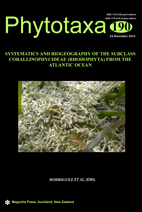Abstract
A taxonomic reassessment of coralline algae (Corallinales, Rhodophyta) associated with reef environments in the Abrolhos Bank, northeastern Brazil, was developed based on extensive historical samples dating from 1999–2009 and a critical evaluation of type material. Our goal was to update the taxonomic status of the main nongeniculate coral reef-forming species. Our results show that four species are the main contributors to the living cover of coral reefs in the Abrolhos Bank: Lithophyllum stictaeforme, Neogoniolithon atlanticum sp. nov., Porolithon pachydermum and Spongites fructiculosus. Comparison of the type material to modern collections has shown that Lithophyllum congestum is a heterotypic synonym of L. stictaeforme. However, L. stictaeforme and P. pachydermum were the most abundant species at the studied sites, a finding consistent with other coral reefs in the region. This is the first record of S. fructiculosus in the southwestern Atlantic. This review provides the baseline data needed for the monitoring and management of the southernmost limits of coral reefs in the western Atlantic Ocean.

